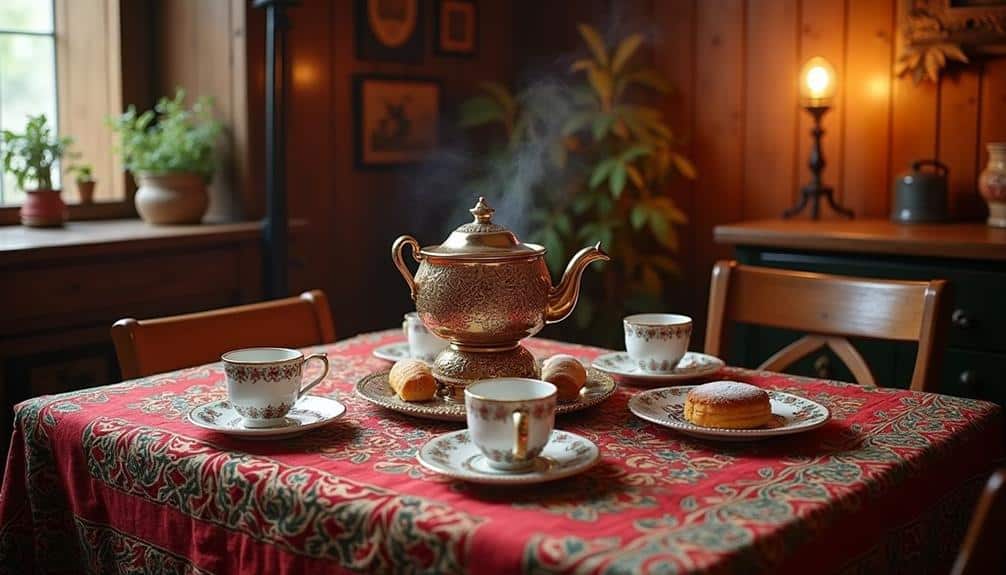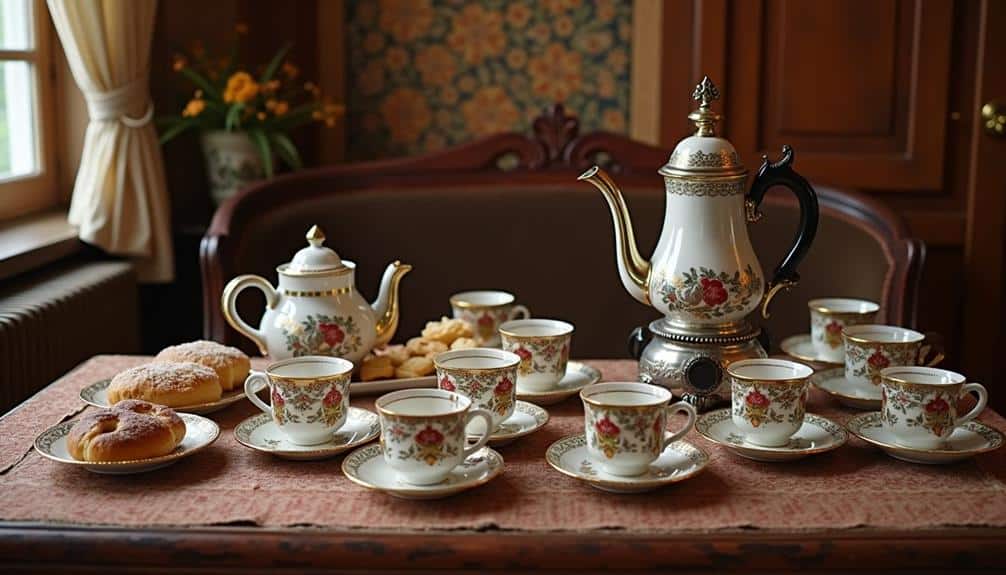Tea holds a profound place in Russian culture, symbolizing hospitality and social unity since its introduction in the 17th century. This cherished ritual transcends social classes, creating an atmosphere of warmth and generosity among hosts and guests. The iconic samovar, a centerpiece in these gatherings, not only facilitates tailored brews but also serves as a conduit for shared stories and deep connections. Accompanied by traditional pastries and preserves, tea time offers a sacred pause for reflection and relationship building. But what truly cements tea’s significance in Russian society? The answer lies in its historical and cultural journey.
Tea as a Cornerstone

Historically, tea has woven itself into the very fabric of Russian culture and traditions, becoming more than just a beverage but a symbol of hospitality and social cohesion. Tea is omnipresent in Russian society, featuring in both daily routines and significant social rituals. It is customary for Russians to offer tea to guests as a gesture of welcome and warmth, reflecting a deep-seated cultural value of generosity and communal bonds.
Tea drinking in Russia is often accompanied by a specific set of traditions and etiquette. The samovar, a uniquely Russian tea-brewing device, is central to these practices. It not only serves as a functional object but also as a cultural icon. The samovar symbolizes the essence of Russian tea culture, emphasizing slow, communal enjoyment over hurried consumption.
In addition, tea is frequently enjoyed with a variety of accompaniments such as pastries, jams, and honey. These are not merely snacks but integral components of the tea experience, enhancing the sense of togetherness and shared enjoyment.
For many Russians, tea time is about more than just drinking tea; it is a sacred pause in the day, a time for reflection, conversation, and connection.
History of Tea in Russia
The history of tea in Russia is a fascinating tapestry of cultural exchange and adaptation. Tea was introduced to Russia in the 17th century when Russian merchants began trading with China. The first recorded instance of tea arriving in Moscow dates back to 1638 when Tsar Michael I received a gift of tea from a Mongolian ruler. This initial encounter sparked a burgeoning interest, leading to the establishment of a direct caravan route between Russia and China.
By the 18th century, tea had become increasingly popular among the Russian aristocracy. The construction of the Trans-Siberian Railway in the late 19th century further facilitated the import of tea, making it more accessible to the general population. The Russian government recognized the economic potential of this commodity and encouraged its importation, leading to the establishment of tea houses and the integration of tea into everyday life.
Throughout its history, tea has transcended social classes, becoming a ubiquitous element in Russian society. It was not merely a beverage but a symbol of hospitality and social connection.
This historical journey of tea, from an exotic import to a cultural mainstay, underscores its enduring significance in Russian life.
Russian Tea Drinking Traditions

Central to Russian tea drinking traditions is the samovar, a uniquely designed metal container used to heat water for tea. This iconic vessel not only serves a practical purpose but also symbolizes the communal and social aspects of tea drinking in Russia.
Traditionally, the samovar is placed at the center of the table, encouraging family and friends to gather, converse, and share stories, reinforcing a sense of community and freedom through shared experience.
Tea in Russia is often consumed in multiple rounds, with each cup carefully brewed to maintain a delicate balance of flavors. The first brew, known as “zavarka,” is a concentrated tea infusion, which is then diluted with hot water from the samovar to personal preference.
This practice allows each individual the freedom to tailor their tea to their own taste, reflecting the Russian appreciation for personal choice.
Accompanying the tea are various treats, including sugar cubes, lemon slices, and traditional pastries like “pryaniki” (spiced cookies) and “baranki” (small bagels).
This rich tapestry of flavors and customs not only elevates the tea-drinking experience but also underscores the cultural significance of tea as a symbol of hospitality and freedom in Russian society.
Regional Variations of Russian Tea
While Russian tea drinking traditions provide a cohesive framework, significant regional variations add layers of richness to the practice. From the urban centers of Moscow and St. Petersburg to the remote expanses of Siberia and the Caucasus, regional differences manifest in both the preparation and consumption of tea, influenced by local customs and available resources.
In the northern regions, particularly around Arkhangelsk, tea is often consumed with cloudberry or lingonberry preserves, giving it a unique, tart flavor. The colder climate necessitates stronger brews, often sweetened with honey to provide warmth and energy.
Conversely, in the southern regions such as the Caucasus, tea is frequently infused with local herbs like thyme or mint, imparting a distinctive, aromatic quality.
Siberian tea traditions often incorporate the use of pine nuts and wild berries, reflecting the region’s abundant natural resources. The tea is typically brewed in a samovar, a traditional Russian tea urn, which adds a ceremonial aspect to the experience.
In Tatarstan, a region with a significant Tatar population, tea is often accompanied by chak-chak, a sweet fried dough dessert, illustrating a blend of Russian and Tatar culinary traditions.
These regional variations not only enhance the sensory experience but also highlight the adaptability and diversity inherent in Russian tea culture.
Cultural Significance

Tea holds a profound cultural significance in Russia, serving as a symbol of hospitality, social bonding, and daily ritual. In Russian households, offering tea to a guest transcends mere refreshment; it is a gesture of warmth and welcoming. The tradition of the samovar, a large, ornate tea urn, exemplifies this ethos. Historically, the samovar was the centerpiece of social gatherings, where friends and family would convene around the table, sharing stories and enjoying each other’s company over multiple cups of tea.
The act of drinking tea in Russia is steeped in ritualistic elements that underscore its cultural importance. It is customary to sip tea slowly, often accompanied by sweet treats like pryaniki (spiced cookies) or varenye (fruit preserves), which enhances the sensory experience and fosters a sense of togetherness. This practice is not merely about quenching thirst but about nurturing bonds and facilitating open dialogue.
Moreover, tea’s integration into daily life serves as a constant reminder of Russia’s rich heritage and hospitality. Whether in urban centers or rural villages, the tradition of tea drinking remains a steadfast pillar of Russian culture, reflecting a deep-rooted appreciation for community and connection.
Modern Trends
In contemporary Russia, innovation and globalization have infused new dynamics into the age-old tradition of tea drinking. As the world becomes more interconnected, Russian tea culture is evolving to embrace a diverse array of influences while retaining its unique heritage.
Urban tea shops and cafes now offer a variety of international teas, from Japanese matcha to Indian chai, appealing to a cosmopolitan clientele. These establishments serve as vibrant social hubs, reflecting the modern Russian’s desire for exploration and cultural fusion.
Moreover, the rise of online tea retailers has democratized access to high-quality teas. Enthusiasts can now purchase rare blends and organic options from around the globe, delivered straight to their doorsteps. This accessibility allows for greater personal choice, aligning with the values of freedom and individuality.
Tea ceremonies are also undergoing a transformation. While traditional samovars and loose-leaf teas remain cherished, contemporary practices often incorporate modern gadgets such as electric kettles and infusers.
These innovations make it easier to enjoy tea in fast-paced urban settings without sacrificing quality.




